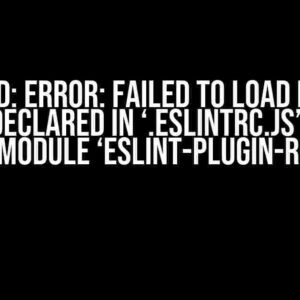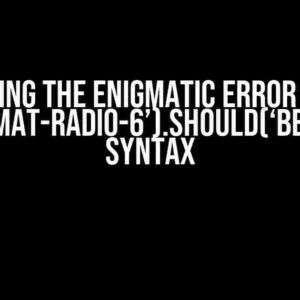When it comes to unit testing in JavaScript, Jest is an incredibly powerful tool. One of its most useful features is the ability to mock out dependencies, allowing you to isolate the code under test and ensure that it behaves as expected. However, sometimes you need to get a bit more specific with your mocking. That’s where jest.mock with requireActual comes in.
What is jest.mock?
jest.mock is a built-in Jest function that allows you to create a mock implementation for a given module. When you call jest.mock, Jest will automatically replace the original module with your mock implementation. This is incredibly useful for testing code that relies on external dependencies, as it allows you to isolate those dependencies and ensure that your code is working correctly.
But what about requireActual?
requireActual, on the other hand, is a function that returns the original implementation of a module, rather than the mocked version. This can be useful when you need to use the actual implementation of a module in certain circumstances, while still mocking it out in others.
When to use jest.mock with requireActual
So, when would you want to use jest.mock with requireActual? Here are a few scenarios:
- You need to test a specific implementation of a module: Sometimes, you need to test a very specific implementation of a module, rather than just mocking it out entirely. By using
jest.mockwithrequireActual, you can create a mock implementation that behaves similarly to the real thing, but with some key differences. - You need to use the actual implementation of a module in certain circumstances: Perhaps you have a module that has some side effects, and you only want those side effects to occur in certain circumstances. By using
requireActual, you can ensure that the actual implementation of the module is used in those circumstances, while still mocking it out in others.
How to use jest.mock with requireActual
Now that we’ve covered the why, let’s talk about the how. Here’s an example of how you might use jest.mock with requireActual:
jest.mock('../myModule', () => {
const actualModule = jest.requireActual('../myModule');
return {
__esModule: true,
...actualModule,
specificFunction: (...args) => {
// custom implementation for specificFunction
},
};
});
In this example, we’re using jest.mock to create a mock implementation of the myModule module. However, we’re also using jest.requireActual to get the actual implementation of the module, and then overriding the specificFunction function with our own custom implementation.
A more complex example
Let’s say you’re testing a module that relies on a third-party library, and you want to mock out that library for most of your tests. However, for one specific test, you need to use the actual implementation of the library. Here’s an example of how you might do that:
const thirdPartyLibrary = jest.requireActual('third-party-library');
jest.mock('third-party-library', () => {
return {
__esModule: true,
...thirdPartyLibrary,
specificFunction: (...args) => {
// custom implementation for specificFunction
},
};
});
// In your test file
import myModule from '../myModule';
describe('myModule', () => {
it('uses the custom implementation of specificFunction', () => {
// Your test code here
});
it('uses the actual implementation of specificFunction', () => {
jest.isolateModules(() => {
jest.dontMock('third-party-library');
// Your test code here
});
});
});
In this example, we’re using jest.requireActual to get the actual implementation of the third-party library, and then overriding the specificFunction function with our own custom implementation. However, in the second test, we’re using jest.dontMock to ensure that the actual implementation of the library is used, rather than the mocked version.
Best Practices for Using jest.mock with requireActual
Here are some best practices to keep in mind when using jest.mock with requireActual:
- Keep your mock implementations simple: When creating a mock implementation, try to keep it as simple as possible. Avoid adding unnecessary complexity, and focus on the specific behavior you need to test.
- Use requireActual sparingly: While
requireActualcan be incredibly useful, it’s not always necessary. Try to use it only when you really need to, and stick to traditional mocking techniques otherwise. - Test your mock implementations: Make sure you’re testing your mock implementations to ensure they’re behaving as expected. This can help catch any unexpected behavior or side effects.
- Document your mock implementations: Consider adding documentation to your mock implementations, explaining why they’re being used and what they’re intended to achieve. This can help other developers understand your testing strategy.
Conclusion
Using jest.mock with requireActual can be a powerful tool in your testing arsenal. By creating custom mock implementations that use the actual implementation of a module, you can create more targeted and effective tests. Just remember to keep your mock implementations simple, use requireActual sparingly, test your mock implementations, and document your approach.
| Scenario | Jest Method | Implementation |
|---|---|---|
| Mocking a module | jest.mock | Returns a mock implementation of a module |
| Using the actual implementation of a module | jest.requireActual | Returns the actual implementation of a module |
| Creating a custom mock implementation that uses the actual implementation of a module | jest.mock with jest.requireActual | Returns a custom mock implementation that uses the actual implementation of a module |
By mastering the art of jest mocking, you can take your testing to the next level and ensure that your code is working exactly as it should. Happy testing!
Frequently Asked Question
Get ready to uncover the mysteries of Jest.mock with requireActual and specific implementation for test cases!
What is the purpose of using jest.mock with requireActual?
jest.mock with requireActual allows you to mock a module while still retaining access to its original implementation. This is particularly useful when you want to test a specific implementation of a module, but still need to use its original functionality in certain scenarios.
How do I specify a specific implementation for a test case using jest.mock?
You can specify a specific implementation for a test case by using the factory function parameter of jest.mock. This function allows you to return a custom implementation of the module, which will be used only for that specific test case.
Can I use jest.mock with requireActual for a specific function within a module?
Yes, you can! By using jest.spyOn and requireActual, you can mock a specific function within a module while still retaining access to its original implementation.
What happens if I don’t use requireActual with jest.mock?
If you don’t use requireActual with jest.mock, the entire module will be replaced with the mocked implementation, and you won’t have access to its original functionality. This might not be what you want, especially if you need to test the module’s original behavior in certain scenarios.
Is it possible to reset the mock implementation to its original state after a test is finished?
Yes, it is! You can use jest.restore to reset the mock implementation to its original state after a test is finished. This ensures that the original implementation is restored, and future tests won’t be affected by the mock implementation.








